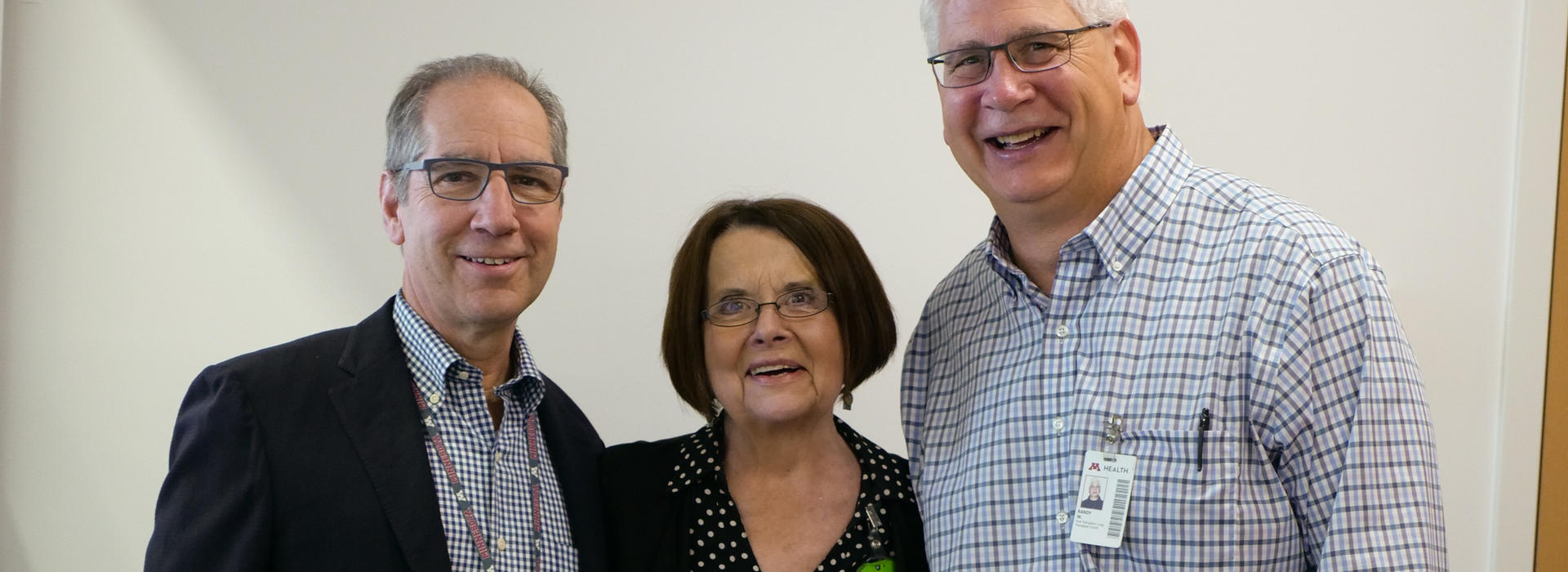
Bilateral Lung Transplant Patient Celebrates 20 Year Anniversary Milestone
Cynthia Torgerson can attest to the growth and innovation the University of Minnesota Medical School’s Lung Transplant Program has seen throughout the past two decades, because she’s lived it.
In 1998, a team of about 20 University of Minnesota Medical School medical experts gave Cindy a bilateral (double) lung transplant. Since then, she has continued treatment and check-ups at the University, under the care of hundreds of care team members over the years.
On July 26th, Cindy and her husband Jerry arrived at the University of Minnesota Health Clinics and Surgery Center for a particularly special appointment--one that marked 20 years after transplant.
Nothing seemed out of the ordinary at first, but when they walked into the room, they were greeted by not only her pulmonologist, Marshall Hertz, the Medical Director of Lung Transplantation, but her three daughters, two of grand-daughters, and one of her transplant care-coordinators. Everyone was there to celebrate this giant milestone with her. It served as a reminder of all of the accomplishments and innovation spurred by 130 years of the University Medical School.
Reaching milestones as patients, and a program
Jerry and Cindy Torgerson will never forget the two-hour drive to the University of Minnesota Medical Center 20 years ago.
“We were holding hands, saying ‘this is it!” remembers Jerry. “We didn’t hit a single red light.”
That day ended two years on the transplant waiting list. Cindy was put on that list after she was diagnosed with rare, genetic lung disease called Alpha-1 antitrypsin deficiency, which often causes Emphysema, with shortness of breath and lung failure.
At the time of Cindy’s transplant, the University of Minnesota performed 30 lung transplants per year. Today, the University of Minnesota performs more than 50 each year, which makes the institution one of the nation’s highest volume lung transplant centers.
Organ donation practice itself has also changed throughout the years. “Third-party” organ procurement organizations--including LifeSource in the upper Midwest--are key for growing the nation’s transplantation programs.
130 years of knowledge, experience, innovation and promise for the future
In March of 2018, the University of Minnesota Medical School Lung Transplant Program celebrated it’s 1,000th lung transplant. Simultaneously, this year the Medical School is celebrating 130 years of education, discovery and research and care.
“The state of programs such as our lung transplant program is a testament to the research and education that begins at the Medical School,” said Hertz. “We have a variety of expertise; people who have done cutting-edge research in their respective areas, and are able to bring that experience into the clinical setting. It is something that can only happen in an academic medical center such as ours.”
Because of the depth of expertise available, the lung transplant program at the University of Minnesota, which was founded in 1986, is one of the largest and most successful lung transplantation programs in the nation. Since its start, the program’s surgeons have performed nearly more than 1,000 lung and heart-lung transplants in children and adults, with outstanding patient survival and quality of life.
Reaching success through an experienced team
On the day of Cindy’s 20th Transplant follow-up appointment, Transplant Care Coordinator Randy Wisdorf and Dr. Hertz represented the lung transplant team, which also includes social workers, respiratory therapists, dieticians, patient financial representatives, and other disciplines.
“The success of this program, and success for each of patients, would not be possible without each and every member of this team. There are a lot of people involved, doing very complicated jobs, very well,” said Dr. Hertz.
The robust care team is a tribute to not only the success of Cindy’s and other patient’s transplants, but to the success of a growing and progressing program.